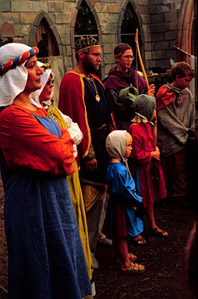Meet the Middle Ages
BackFeasts

The difference between workdays and holidays was very clear to medieval people.
People celebrated when a baby was born and christened, when the mother could go to church again after child-birth, and when a boy and a girl got engaged and married. There were also feasts at the funerals and when a legacy was divided. On all these occasions, friends and neighbours were invited and lots of good food was served. The law , however, prescribed a maximum number of people allowed at feasts and celebrations. There might be fights and disorder, if many people were celebrating, especially if beer and wine was offered. The Town Law of Magnus Eriksson allowed a maximum of 24 guests when there was a feast for a baby, and 40 persons at a funeral. Whether the law was upheld is another matter.
A wedding meant a huge celebration. Before the wedding, the friends made a lot of jokes about and with the bride- and groom-to- be. An important thing for the young bride was the bath she took with her friends. The wedding took place outside the church, followed by Mass inside the church. The law prescribed that a wedding feast should last for two days, but a third day was not unusual. 60 people could be invited. If there were more guests, there was a great risk of fights disturbing the peace. On the first night, the couple was brought to bed with the priest’s blessings. In the morning, the husband would give the bride a "morgongåva" ("morning gift"), a present as a token of his love for her. If he was a rich nobleman, he may even give his wife a manor-house.
If you would like to know more about the feasts of the year, you can read "Country Life. Workdays and Holidays".